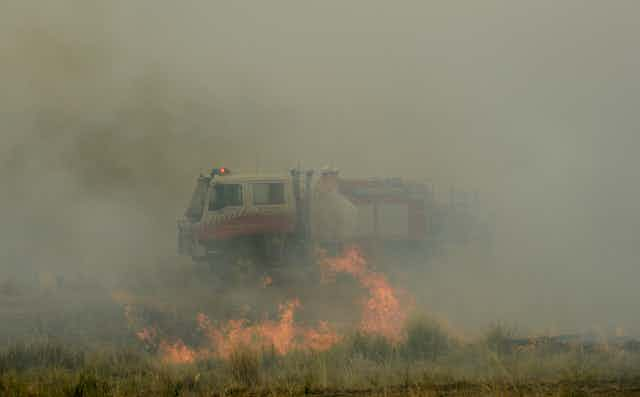Bushfires have been the most common natural disaster in New South Wales over the past decade, according to our study published today in Nature’s Scientific Reports.
Our study, the first of its kind, looked at disaster declarations in local government areas (LGAs). We found 207 disasters affected the state between 2004 and 2014. Bushfires were the most common, responsible for 108 disaster declarations, followed by storms (55) and floods (44).
By looking at where disasters were declared, we found a “hotspot” in northern New South Wales, which includes some of the state’s most disadvantaged communities.
This suggests that to help communities prepare for disasters, we need to address underlying causes of disadvantage.
There’s nothing natural about a disaster
Disasters are a regular part of life for communities across the globe. So far in 2016, disasters have cost US$71 billion and claimed some 6,000 lives. Globally, the number and cost of disasters is rising.
Australia has a long history of natural disasters, from catastrophic bushfires to flooding rains. Many people are asking whether such disasters are becoming more frequent, and what we can do to better prevent and prepare for them.
Despite the way we talk about them, fires, floods and storms are not inherently natural disasters. Though they may threaten social systems or the environment, they are more accurately classified as natural hazards.
A disaster occurs when a natural hazard overwhelms a social system’s capacity to cope and respond. Instead, disasters require many agencies and a coordinated response. Many factors such as vulnerability, resilience and population density influence a how a community copes with hazards.
Natural disasters are therefore socially constructed, and this is in Australian legislation on how disasters are declared.
What types of disasters are most common in NSW?
Using data on local government areas (LGAs) involved in Natural Disaster Declarations we examined three types of sudden hazards - bushfires, floods and storms. We found that LGAs in New South Wales were involved in disaster declarations on 905 separate occasions.
Across the state, 27 LGAs experienced no disaster declarations. All of these were located within the Greater Metropolitan Region around Sydney. The highest numbers of disasters declared were in Clarence Valley (21), Richmond Valley (16), Narrabri (15) and Nambucca (15).

While bushfires were the most commonly occurring type of disaster event, floods affected the highest number of LGAs. Bushfire and storm disasters were most common in 2012-13, and floods in 2010-11.
By analysing these data we found a cluster or hotspot in the state’s north east. LGAs here were much more frequently involved in disaster declarations than elsewhere.

What’s causing these disasters?
We found clear differences between the number and type of disaster declarations in different years. We wondered if disasters were linked to El Niño (which can lead to hotter, drier weather in Australia) and La Niña (which can lead to cooler, wetter weather).
We did indeed find that bushfires were more common in hot, dry El Niños, and floods and storms in wetter La Niñas. But the relationship wasn’t “statistically significant” - which is how scientists decide how important a statistical finding is.
This suggests that for NSW at least, the strength of El Niño and La Niña is not a good predictor of the number of bushfire, storm or flood disaster declarations that will be made. This might be for two reasons.
First, the declaration of a disaster is based on its socioeconomic and human impacts – not the physical size or intensity of the actual event. And second, we only have a good data set of disaster declarations back to 2004, a very short period of time to look for detailed patterns.
We also compared disaster declarations to the Australian Bureau of Statistics’ Socio-Economic Indexes for Areas data, a dataset that ranks communities on their relative social disadvantage. Research shows that vulnerable, disadvantaged communities are more susceptible to hazards and disasters.
We found that of the most disadvantaged LGAs in NSW, 43% were found in the state’s disaster hotspot.
While we don’t know exactly why so many disadvantaged communities are found in the disaster hotspot, this demonstrates the role that social disadvantage plays in influencing susceptibility to disasters. This builds on other recent studies about inequality and disadvantage in Australia.
The key message for Australia, and the world, is if we do not deal with the root causes of inequality, injustice, disadvantage and poverty, no amount of spending on disaster risk management will stem ever increasing disaster losses.
What can we do?
The overlap of disadvantage and disaster declarations presents a challenge to communities, disaster managers and governments. Increased funding to address social disadvantage in these communities may increase resilience to natural hazards, preventing them from becoming disasters.
Even Sydney, where all of the LGAs with no disasters were found, shouldn’t become complacent. Areas with less experience of hazards have lower awareness of the risks, and respond less effectively as a result. So even though metropolitan areas are typically better off, if a disaster were to occur, the population here would likely be less prepared to cope with the impacts.
Community outreach and education programs may help increase general awareness of the risks and help communities become better prepared. Similarly, more training and deploying emergency services personnel to disasters elsewhere could help gain insight and experiences which can be brought home.
The 2011 Queensland floods demonstrated the need for better education, risk communication and community awareness.
With flood disasters the most widespread across NSW, it would be prudent to focus on educating communities about floods to increase resilience and help them cope. Increasing resources for the State Emergency Service will also allow for more effective planning, mitigation and response strategies to be developed and implemented.
The damage bill from recent flooding across NSW topped A$500 million. The Bureau of Meteorology has predicted an above-average 2016-17 cyclone season. It is an apt time to pause and reflect on what drives people’s understanding of disaster risk and community resilience.

